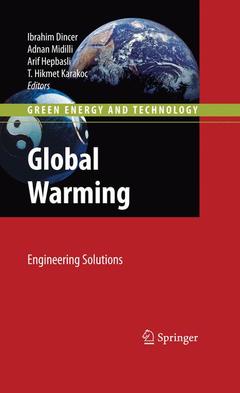Global Warming – Where Is the Cure?.- On the Principles of Thermodynamics – Effects on the Environment, Global Warming, and Sustainability.- Role of Renewable Energy in Sustainable Development.- Residential Solar Power Generation Systems for Better Environment.- Hydrogen Production from Ammonia as an Environmentally Benign Solution for Vehicles.- Environmentally Benign Nuclear-Based Hydrogen Production.- Environmental Benefits of Geothermal-Based Absorption Cooling Systems.- Reducing Greenhouse Gas Emissions from a Landfill Site Using Various Thermal Systems.- Partial Gasification for CO2Emissions Reduction.- A Strategic Program to Reduce Greenhouse Gas Emissions from Food Industry.- Environmental and Economic Issues from Changing a Major Fuel Type as Energy Resource in an Industrial City in Korea.- Emission Characteristics of Diesel Engine-Powered Cogeneration Systems.- Effects of Fuel Consumption of Commercial Turbofans on Global Warming.- Marnoch Engine Performance for Multiple Pressure Vessel Configurations.- Exergy Analysis of Food Drying Processes.- Carbon Sequestration: A Comparative Analysis.- Coal-Based Hydrogen Production with CO2 Capture in?the Aspect of Clean Coal Technologies.- CO2 Absorption in a Mini-module Membrane Contactor.- CO2 Hydrogenation to Methanol on Cu–ZrO2 Catalysts.- CO2 and SO2 Capture Capability of Two Greek Limestones.- Effect of Oxidative Medium on Removal of Sulfur and Mineral Matter from the Can Lignites.- Biogenic Emission and Essential Oils of Some Eucalyptus Species: A Comparison Study.- Embodied Carbon: The Concealed Impact of Residential Construction.- Sustainable Construction Practices in Malaysia.- Emission Market at the End of the Commitment Period.- Game Analysis of Kyoto and Post-Kyoto Schemes.- Enterprise RiskManagement Perspective.- Environmental Assessment of Solar Heating and Cooling Systems in Kuwait Climate.- Steam Network Optimization by Utilizing Biomass and Solar Energy Sources in an Oil Refinery.- Calculation of Global Solar Radiation Based on Cloud Data for Major Cities of South Korea.- Relationship Between Air Pollutants and Some Meteorological Parameters in Erzurum, Turkey.- Planning for the Impacts of the Caspian Sea Level Rise and Climate Change in the North of Iran.- Impacts of Climate Change on Water Resources in Saudi Arabia.- Warming Tendency in the Eastern Mediterranean Basin and Its Influence on West Nile Fever Outbreaks.- Water Management Works in Târnava River Basin, Romania.- North–South Gap in Wastewater Management: A?Comparative Study for Germany and Jordan.- A Pervaporation Application for Treating Methyl tert-Butyl Ether (MTBE)-Contaminated Water/Wastewater.- Temperature Variations and Their Effects on Rainfall in Nigeria.- Multimedia Pollutant Sources and Their Effects on the Environment and Waste Management Practice in Turkish Shipyards.- Nitrous Oxide Emission from Agricultural Practices in Japan.- Phenological Adaptation of Cereal Weeds to Climate Variations.- Chemical Characteristics and Source Reconciliation of Organic Aerosols in Algiers City Area.- Removal of Cu2+ and Ni2+ from Aqueous Solution by?Algerian Clay Materials.- Health Impacts of Heat Waves of 2007 in Hungary – Background and Experiences.- Potential Impact of Climate Change on Pandemic Influenza Risk.





